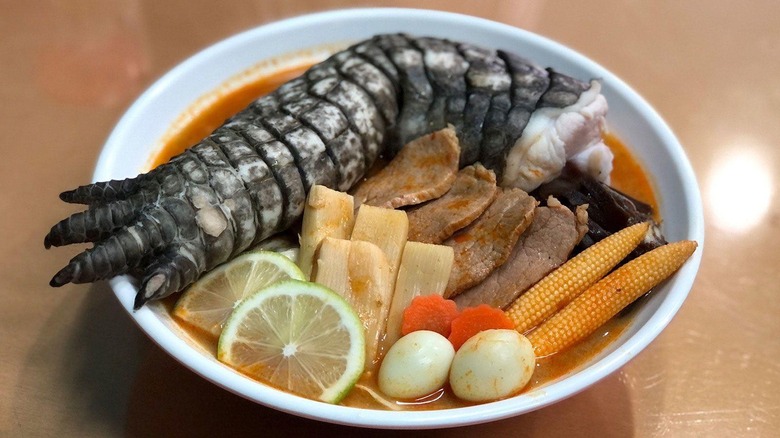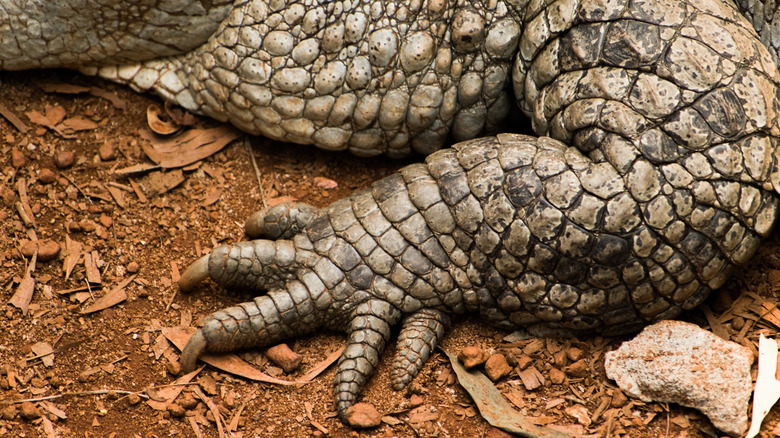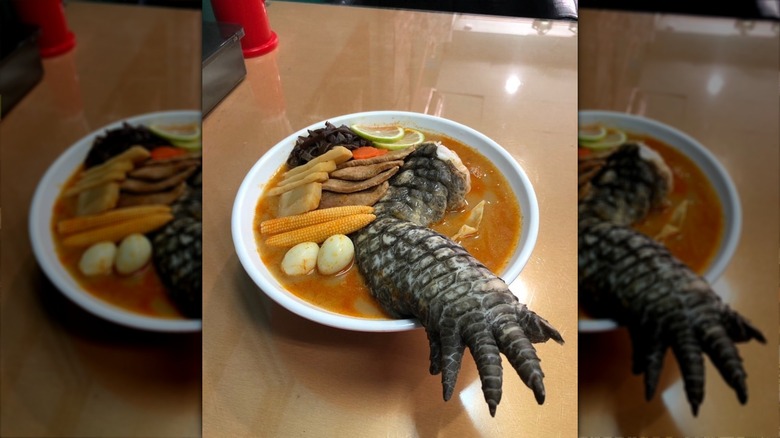The Taiwanese Ramen Dish That Slings Serious Godzilla Vibes
Ramen lovers, there's a bowl served up in Taiwan that may require an extra dose of mettle to dig into. Whether you've been adding tangy Ranch seasoning to steaming bowls of noodles or have tried experimenting with canned soups to create unique flavor profiles for your ramen recipes, there's one ingredient you most likely have not tried: crocodile meat.
In Taiwan, farming crocodiles is a legal practice as long as the species aren't on a protected list, yet the difficulty in procuring a front leg of a crocodile means that only a limited number of these sci-fi-looking bowls can be served to diners. Unsurprisingly, a waiting list to sample the unique delicacy has formed.
To make the dish, the owner of Witch Cat Kwai, whose last name is Chien, sources crocodiles from a farm in Taitung, a city along Taiwan's southeastern coast. Understandably, the unique presentation has attracted some serious attention.
The makings of a memorable dish
Located in the south of the country, Witch Cat Kwai has earned a reputation for serving up hearty bowls of noodles with the inclusion of a small crocodile arm garnishing the bowl. The broth the ramen is served in is derived from a recipe that Chien learned to make in Thailand, per Today Online. Witch Cat Kwai isn't the first Taiwanese restaurant to garner press from ramen bowls, however; another restaurant, Ramen Boy, has been known to crown ramen orders with large isopods, lengthy 14-legged steamed crustaceans whose appearance has commanded social media updates.
Witch Cat Kwai's Godzilla Ramen has achieved similar culinary fame with the addition of the crocodile leg. In case customers order the dish without the intention of actually eating the leg (and simply using photos for Instagram posts) Chien issues a fee to discourage such behavior. Chien wants customers to actually eat the ingredient, which he describes to CNN Travel as tasting similar to chicken, but with a softer, chewier texture. "I think it tastes like braised chicken feet," he said.
Ingredients for one-of-a-kind ramen
Chien told CNN Travel the dish is made similarly to other ramen bowls made with pork, quail eggs, baby corn, dried bamboo shoots, black fungus, and cubes of fish paste dropped into the recipe. To prepare the crocodile, the leg is first cleaned, rubbed with alcohol, coated in spices, then left to cook in a broth of over 40 different ingredients for several hours. To finish the specially prepared order, the front leg of a crocodile is placed into the bowl with claws outstretched over the edge of the dish.
Since preparing crocodile legs for these custom orders take time, only two bowls, which cost around $50 a piece, are made each day, and orders must be placed in advance. If you're interested in putting together a ramen dish at home that will earn similar awe from your guests — sans body parts of various creatures — flying noodles offer an impressive photo-worthy presentation, without the need to source any reptilian legs.


